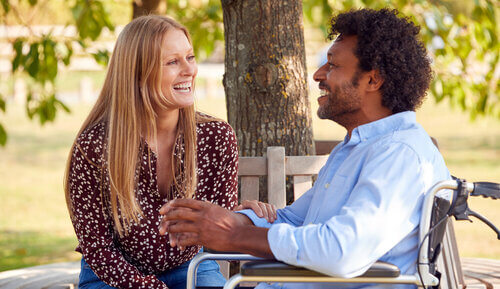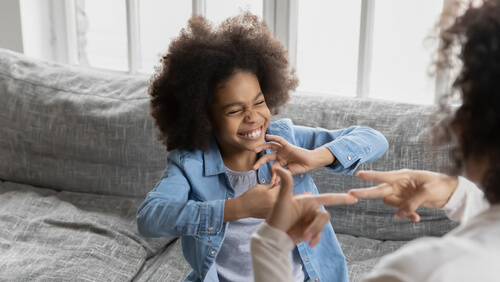
Page contents
I was given the chance to experience the world from an autistic person’s perspective and get a glimpse of their autism symptoms by trying out the Autism Reality Experience.
This immersive simulation experience replicates the sensory overload you can face on a daily basis if you are autistic. The Autism Reality Experience was created by Training 2 Care, with input from 150 autistic people.
First, I entered a blacked-out van and it was immediately unnerving. Visually it felt like the floor was escaping from me. Suddenly vulnerable and unsteady on my feet, It was as if the ground was uneven and I would fall. My vision was showing me a blurry, off-kilter world…so I held onto a door handle.
Blurred vision
I was taken by the hands and led into a dark room, where green, red and blue dots of light raced around the place.
A screen showed a clock loudly tick-tocking, a tap slowly drip dropping, a vacuum cleaner sucking out the quiet from the room.
I had been told to sit down and watch a screen in this darkened space but even the chair was hard and unwelcoming, with strange ridges.
The woman in the corner watched as I scrutinised the images being shown. I had been told to wait for instructions. A few instructions came occasionally spliced in between much banging, splashing and tick-tocking.
Most of the time, my senses were under attack.
Overwhelming smells
An onslaught of sounds, sights, textures and smells closed in.
Baby powder, coffee and fresh bread wafted in the air making a strange perfume. I felt overwhelmed. A little anxious.
I wanted to get up but the woman told me to sit down again, and again, to listen to what seemed like an army of unwanted guests.
Sporadically came five or six basic instructions. I could recall: ‘Write your mother’s maiden name on the blue post-it note’; ‘spell out the word autism on the wooden blocks’; ‘find seven green tiddlywinks’; ‘find the five of spades’.
Restless, distracted, frustrated
Keen to act on the information and get started, I was restless, distracted.
Frustrated by this new normal, the desire to get up and do something was great.
Eventually, I broke free from my…my.. carer? and rushed to the boxes at the opposite end of the room.
Lifting the lid, I found it was a perplexing task to pick out green tiddlywinks amongst a multi-coloured box of them. I brought them close to my face.
The dark, the flashing lights and blurry vision had distorted the colours. Like someone had washed and laundered my senses and given me two odd socks that didn’t fit.
Lack of gripping skills
Colours, I realised, were not my only problem. My hands wrapped in disposable gloves (and what seemed like bumpy, gardening gloves with a bit of reinforced plastic in the odd finger) messed about with my gripping skills.
Reaching another box, I wondered…how many 2ps had to be counted out? Twenty pence worth, I guessed. And put it where?… in the blue piggy bank?
Small victories felt huge
Box number three had me diving into a scattered pack of playing cards and cack-handedly managing to direct my digits to pluck out a five of spades! This small victory felt huge.
All the while everyday household sounds were played at full whack in my ears. As I wrestled with basic tasks, the clock wound down and time was up.
I left weary but relieved to be free of this room.
‘Seams distress him’
Was this what autism is like? Chelsey Cookson should know. Her son Lewis was diagnosed with autism when he was four-years-old. She is keen for people to know about the sensory struggles he has battled with.
Chelsey says of the Autism Reality Experience: “It’s specifically designed and geared up to give somebody an idea of what it’s like when somebody has too much sensory stimuli.”
Describing Lewis’ autism, she says sensory overload can make a person over-sensitive to tactile information.
“It can make it quite difficult for him to manage day-to-day things. He turns the socks inside out because the seams are distressing him.
“I’m much more patient and much better at preparing him for environments where I think there could be some triggers for him feeling quite anxious and distressed.”
What is autism?
Autism spectrum disorder (ASD) is the medical name for autism. Around 700,000 children and adults in the UK are on the autism spectrum.
Autism is a lifelong developmental disability that a person is born with. Some people with autism need little support, while others may need help from a parent or carer.
When it comes to autism symptoms, autism affects how a person communicates with and relates to other people. While everyone’s experience is unique, some 96 per cent of people with autism have a sensory processing disorder. They see, hear and feel things differently. Autistic people may experience over- or under-sensitivity to sounds, touch, tastes, smells, light, colours, temperatures or pain.
They can struggle to understand and may have difficulty interpreting both verbal and non-verbal language like gestures or tone of voice. People with autism also struggle with social communication, social interaction and anxiety issues.
An autistic person may find it hard to express their own emotions and understand how someone else thinks and feels.
Raising autism awareness
The Autism Reality Experience is hands on training developed to give non-autistic people an experience of the sensory processing difficulties faced by people on the autism spectrum. The tour forces a person’s sensory processing system to work hard.
Anyone can have an over or under responsiveness to one of the senses. Ms Cookson talks of 22 senses gifted to the human body.
The Autism Reality Experience plays around with your senses. In particular your sight, hearing, smell, touch and proprioception (the ability to tell where body parts such as muscles and joints are, relative to other body parts). It also messes with your vestibular system which equals the sense of balance and movement and is closely linked to gravity and attention.
Autism Reality Experience shaped by people with autism
Occupational therapists, autism specialists, parents and trainers from the National Autism Society who have autism, have road-tested the tour. Their feedback has honed the final experience.
Chelsey Cookson, who works for Training 2 Care UK, says: “It was important to involve people with autism because they can tell you how realistic it is.”
Staff from care homes, hospitals, police forces and prisons have been through the Autism Reality Experience, which can be tried across the UK because this autism world is conjured up in a van.
Ms Cookson is hopeful greater understanding of autism gained from the tour will breed greater empathy to help educators and care workers support others.
“Autistic people may need lots of vestibular input. At school, an autistic person may be moving in order to regulate themselves to listen. To concentrate they need to move.”
When asked how her son is, she says: “He is doing well. He had been struggling to sleep. When we created this reality experience, I had gaps in my knowledge. I’ve learned more.”
Having learned that a bed sock could help her son, she got him a weighted bed sheet to use at home and at friends’ sleepovers. It replicates weighted therapy by providing compression on the body.
She adds: “It has stopped him being up all night.”


